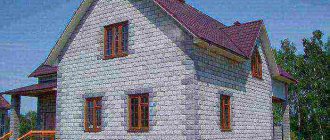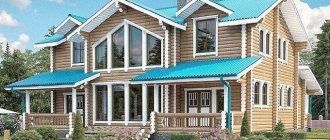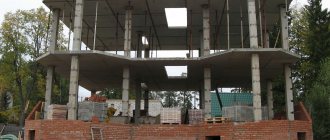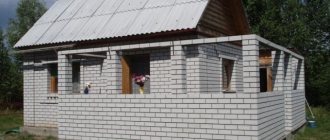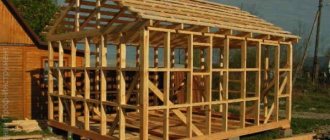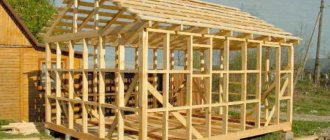Home |Construction |How to raise a house with your own hands: step-by-step instructions
Date: June 13, 2017
Comments: 0
The use of wood for the manufacture of cottages and country houses is popular. Many people prefer logs, panel structures and beams, which are environmentally friendly and, subject to special processing and proper installation, ensure the durability of the building. During the operation of houses made of wood, it becomes necessary to restore the foundation or replace the supporting crown. The light weight of wooden buildings allows the house to be lifted using powerful jacks.
Knowing how to raise a house with your own hands, you can move a one-story building vertically and temporarily fix it with concrete blocks or metal supports. At the same time, it is important to prevent collapse, maintain the integrity of the finish, and not disturb the geometry of window and door openings.
Before you start lifting the house, you need to do a number of preparatory work
When making a responsible decision to jack up a house without hiring hired workers, you should perform a set of works, prepare the tools and materials necessary for lifting, and also carefully study the technology. Particular attention should be paid to observing safety precautions. Let us consider this complex of issues in detail.
Preparatory work, necessary materials and tools
At the preparatory stage, it is necessary to inspect the building, assess the degree of complexity and duration of the planned repairs, determine the method of lifting, and carry out work to protect the structure from destruction during movement.
If there are problems with the foundation, there are two options - build a new house or try to restore and replace it
The need for repairs by lifting a wooden building is indicated by visual signs:
- significant skew or tilt of the house;
- the appearance of a network of cracks on the interior and exterior finishes;
- local or complete subsidence;
- deepening part of the foundation into the ground;
- significant violation of the integrity of the foundation.
The vertical movement of the structure is carried out to carry out the following types of activities:
- Performing partial or major repairs of the foundation.
- Preventing subsidence of the structure.
- Replacement of rotted support beams around the perimeter of the building.
- Alignment of box distortions.
- Carrying out protective treatment of wood.
- Eliminating mistakes made by builders.
Most often it is necessary to raise a wooden house when problems arise with the foundation
In order to determine the method by which the house will be raised using special devices, the following factors are analyzed at the preliminary stage:
- mass of the building. Each jack must provide a 40% lifting capacity. To do this, the total weight of the structure is calculated by multiplying the cubic capacity of the box by the specific gravity of wood equal to 0.8 t/m3. The weight of the floor, roofing and finishing is added to the resulting number;
- dimensions of the building box. With a building length of more than six meters, there is a high probability of beams or logs subsiding in the splice zone. Additional installation of supporting elements at the joining areas will be required;
- presence of internal lining. Using plasterboard sheets or plaster to decorate walls indoors complicates the implementation of activities. Installing 50 mm thick boards on the outside of the corners will avoid repeated repairs indoors;
- soil features. Depending on the structure of the soil on which the lower plane of the lifting device will rest, it may be necessary to use concrete blocks or special panels of increased area. This will prevent the jack from sinking;
- travel height. The length of the working stroke of the rod is limited by the design of the lifting device. The use of special pads made of durable square-section timber with a side size of 100–150 mm will allow you to gradually achieve the required moving height;
- duration of repair activities. The duration of the repair is determined by the degree of complexity; if it is carried out for a long time, it is undesirable to rest the structure on the rod. It is advisable to use temporary structures made of metal and wood that have sufficient supporting area.
Sometimes a bad site is chosen to build a building, then they put a new foundation in another place and drag the house
Raising the house to the height required for repairs can be carried out using the following equipment:
- By crane.
It is used mainly for the purpose of lifting to move buildings to another site. - Powerful jacks.
A widespread method of moving wooden buildings in a vertical plane.
When planning to raise a house on jacks, you should prepare:
- cut off the power supply;
- turn off the gas supply;
- shut off water mains;
- turn off the sewer system;
- ensure free movement of a stove installed on an independent foundation through the roof of the chimney;
- disconnect the individually mounted boiler from the heating pipes;
- dismantle the floor in the area of the stove and heating boiler;
- secure the immobility of the box with steel plates screwed to the corners.
Use a jack to lift the frame slightly. Only 2-3 cm at a time
To complete the work you will need the following materials and tools:
- Hydraulic type jack with a lifting capacity corresponding to the design value.
- Support panels made of wood, allowing to reduce the load on the ground when installing lifts.
- Set of metal pads measuring 20–30 cm.
- Grinder equipped with a disc.
- A set of tools for detaching the support beam around the perimeter of the building.
Preparing to install jacks
Depending on the type of foundation, the installation of jacks has its own characteristics. To do this, rectangular openings are cut out in concrete or lower rims, where load-lifting structures are located. If the building is installed on stilts, then it is enough to place wooden panels on the soil, which will become a support for the lifts.
For partial renovation of a room, metal stands and strips with a thickness of 20 mm or more are purchased. The weight of the perceived load is up to 5 tons.
In the case of a complete replacement of the foundation, the production of a powerful welded structure is required. For this purpose, metal channels and corners are purchased. After lifting the house, they take on the entire weight of the building.
Before installing the jacks, the lower logs of the crown are inspected. If rot is detected, then these places are strengthened. The distance from the corner is measured at 1-2 m, and between the jacks it is 3-4 m.
Types of jacks for raising a house
Lifting a house to the height necessary to carry out repairs can be carried out by various types of lifting devices:
- screw.
They are distinguished by their simplicity of design and reliability of the lifting mechanism. The load is taken by a support platform fixed perpendicular to the axis of the threaded screw. The screw-type lift is characterized by increased load capacity, ease of maintenance and compact dimensions; - hydraulic.
The operating principle is based on the ability of a pressurized liquid to move the piston of the device. Pressure is created using a special inflation lever. Hydraulic devices are more complex when compared to screw lifts.
The reliability of the devices allows them to be used to raise a house.
We recommend that you pay attention to models with a load capacity approximately 20% greater than required
Process Features
To raise a wooden structure, it is recommended to prepare the base for supporting the jack. The supporting platform must provide not only stability, but also freely accept the pressure from above. The raw material used is board or timber. The support is laid on the subgrade or foundation to ensure uniform distribution of the impact over it. If laying is done on the ground, it must first be compacted well.
Sliding is prevented by securely fixing the jack head when it comes into contact with the house. The main condition is the evenness of the log in the place to which the lifting force will subsequently be applied. It is allowed to use a metal plate measuring 10*10 cm with a slightly concave shape in the center. It is she who is subsequently placed between the jack and the wooden house.
How to raise a house with your own hands - detailed instructions
To lift a house with a jack, a different number of lifting devices can be used depending on their availability and the weight of the structure:
- use of one lift.
When moving various points of the building one by one, it is important to make a vertical displacement of no more than 5 cm in one cycle. This will avoid irreversible deformations, which can result in skewed doors, cracking of the finish and damage to the integrity of the glass. The raised area is fixed with bars, and the jack is moved to the next area. Performing operations allows you to consistently raise the house to the same level; - use of two lifting devices.
Vertical movement devices should be positioned correctly and both points should not be hung simultaneously. Each section is lifted in turn, which prevents the building from moving in the direction opposite to the lifts and being seriously deformed. The lifting algorithm using two devices is similar to the previously discussed option; - synchronous operation of four devices.
The use of equipment installed in the corner areas of the building makes it possible to lift a wooden structure as efficiently and safely as possible, moving 2–4 cm at a time. It is important to ensure synchronization to ensure smooth movement by giving a voice command to the workers. It is possible to use professional equipment equipped with a synchronous control system.
Place the jack on a strong wooden board, and between the head of the jack and the log against which it will rest, place a steel plate with a recess for the head
The step-by-step methodology recommends performing jacking activities, following the sequence of operations:
- Determine the lifting pattern and the location of lifting devices.
- Compact the soil where the jacks are located.
- Place larger supports under the lifting device.
- Form a support plane using plates in the rod contact area.
- Lift each section to a height of no more than 2–4 cm in one cycle.
- Install, if necessary, fixing pads.
- Carry out work by controlling the position of the house with a level and ensuring its uniform movement.
- Place powerful stops in the work area to ensure that the structure cannot be lowered in the event of an accidental failure or breakdown of the lifting device.
If it is necessary to ensure synchronous movement of lifting mechanisms located on opposite sides of the building, use a metal beam located under the building and supported by rods.
What kind of house can be raised
In principle, specialists lift houses of any type, including brick or block ones. But you can only handle wooden houses with your own hands - made of logs, timber. You can also lift panel wooden houses yourself. All of them, due to their design, can easily withstand uneven loads, so when lifting you can use one or two powerful jacks. They are usually rearranged around the perimeter - moving clockwise or counterclockwise, little by little raising the frame with its foundation. Due to the fact that wood is elastic and resilient, the slight distortion created during operation is compensated, preventing the building from crumbling or cracking. This, and the low weight of wooden structures, allows you to lift them with your own hands.
This is how a block or frame house is lifted - many hydraulic jacks controlled from one point
Brick or block houses will not withstand such an operation. They react very poorly to distortions and unevenly applied loads. Because this process is much more complex and expensive. Steel beams are placed under the building, creating a reinforcing belt below. Powerful pneumatic jacks are installed around the perimeter, which are controlled from one point (control panel or computer). They begin to rise at the same time. Only in this case is it possible to avoid the destruction of a brick, frame or block house.
Raising a building using jacks - precautions
Compliance with safety requirements when performing work is mandatory. Pay special attention to the following points:
- mandatory strengthening of the box with thick boards;
- installation of spacer beams in door and window openings;
- ensuring the immobility of the jack location;
- checking the strength and strengthening of wood in the area where the support rods are located;
- use of special steel thrust bearings.
By lifting and ensuring the structure is stationary, you can safely carry out repair work
Controlling the lifting height of the house
To control the height of the house being raised into the ground, a rail with a mark is installed near the corner. The same mark is applied to the corner of the house. When lifting, the mutual movement of these marks will show the height of the rise of the house structure. It is impossible to control the lifting height by the amount of extension of the jack rod, because it does not give an exact value - the jack may sag under the load from the weight of the house.
Particular attention should be paid to the position of the jack - it must be strictly vertical. If the slightest tilt appears, you must immediately stop lifting and secure the jack in the desired position.

